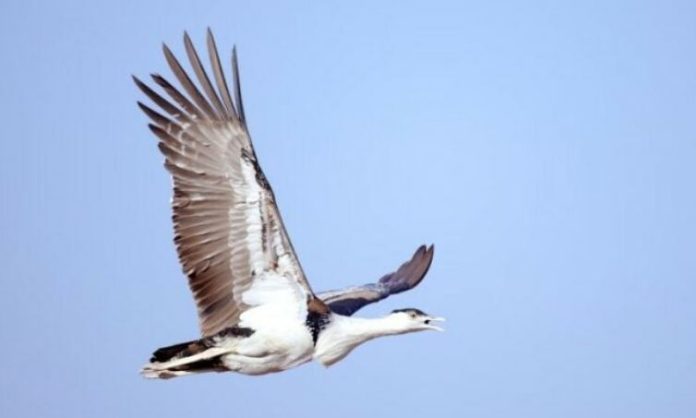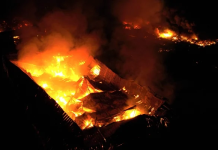PESHAWAR, Nov 16 (APP/DNA): As the golden wash of autumn fades and a crisp winter breath settles over Pakistan, an ancient rhythm awakens above the plains and mountains of Khyber Pakhtunkhwa.
Long before the first frost touches the soil, the sky stirs with the flutter of wings as thousands of migratory birds including houbara Bustard started returning from the frozen steppes of Central Asia and Siberia to Pakistan.
Their arrival, delicate yet determined, transforms Pakistan into a living, breathing mosaic of colour, sound, and movement amid chirping birds.
From Chitral to Karachi and Gowadar to Cholistan, wetlands glisten with life, deserts hum with activity, and forests echo with soft calls and quiet landings.
Among these passing guests, one bird embodies both the grandeur and fragility of migration is the houbara bustard.
“Pakistan lies at the crossroads of the great Indus Flyway,” explained Dr. Mumtaz Malik, former Chief Conservator of Wildlife.
“From the icy crowns of the Karakoram and Hindu Kush and deserts of Cholistan to Tharparkar and plains of DI Khan to Rahimyar Khan, these birds follow the Indus River down to Sindh, resting in wetlands and arid pockets along the way.”
This natural corridor stretching from Chitral and Dir to Kohat, Dera Ismail Khan, and onward to Punjab and Sindh offers warmth, food, and sanctuary.
Expanding forest cover and rehabilitated habitats have made the country a preferred winter refuge for pintails, mallards, teals, pelicans, cranes, geese, and the elusive houbara bustard.
Graceful, shy, and mysterious, the houbara bustard holds a special allure for falconers and conservationists alike. It moves in disciplined flocks, always guided by a a chieftain, as Dr. Malik describes.
“If the leader perishes, the deputy takes charge. Their sense of community is remarkable.”
Sensitive to disturbance, the houbara may abandon traditional routes if danger is sensed even once. It survives on insects, wild fruits, and small reptiles abundant in Pakistan’s arid belts—Dera Ismail Khan, Rahim Yar Khan, Cholistan but its reproductive chances are slim.
“A houbara lays only two eggs, and often the first chick kills the second,” Dr. Malik said. “If it loses a mate, it may take up to five years to find another.”
For a species already struggling, every lost pair is a heavy blow. Despite Pakistan’s natural hospitality, the journey of these feathered guests has grown increasingly perilous.
Illegal hunting and poaching cast long shadows over their seasonal passage. Climate change shrinks wetlands, disrupts food cycles, and pushes species toward the brink.
“The rivalry between siblings, poaching, and habitat loss are pushing populations downward,” Dr. Malik warned.
The Siberian crane, white-backed vulture, saker falcon, and over 90 other species—including the Indus dolphin and Baluchistan bear now stand endangered or vulnerable.
Even as risks intensify, Pakistan’s conservation landscape is quietly transforming. Massive afforestation drives such as the 10 Billion Tree Tsunami Project (BTTP) and Green Pakistan Program are expanding the lungs of the country.
“With increasing forest cover, the frequency of migratory birds including houbara population has increased manifold, to Pakistan,” said Muhammad Ibrahim Khan, Deputy Project Director of BTTP.
Newly grown forests like Ghari Chandan in Peshawar and DI Khan have become bustling breeding grounds for visiting species.
He said national parks from Saiful Maluk’s icy lakes to Chitral Gol’s alpine forests act as strongholds for wildlife protection.
In a pioneering move, the Khyber Pakhtunkhwa Forest Department has launched a rewilding project, releasing deer species into Kohat’s forests under drone monitoring.
“We are combining technology with community participation to restore natural balance,” said DFO wildlife Salahuddin Khan.
For conservationists, the battle is no longer just against poachers, timber mafias, or shrinking wetlands but it is against time itself.
“Wildlife protection cannot succeed without community support,” urged Dr. Malik. “These birds cross borders; their protection must also transcend boundaries.”
Experts stress that NGOs must step up to educate communities, wildlife laws must be enforced with renewed vigour, and protected areas must expand to support breeding grounds for the houbara and other migratory species. Empowering wildlife staff with policing authority, many believe, will be a critical turning point.
As winter deepens and wetlands shimmer under a softer sun, Pakistan once again becomes a sanctuary not just for birds fleeing the severe northern cold, but for hope itself.
Every wingbeat across the Indus skies is a whisper of hope and resilience.

















